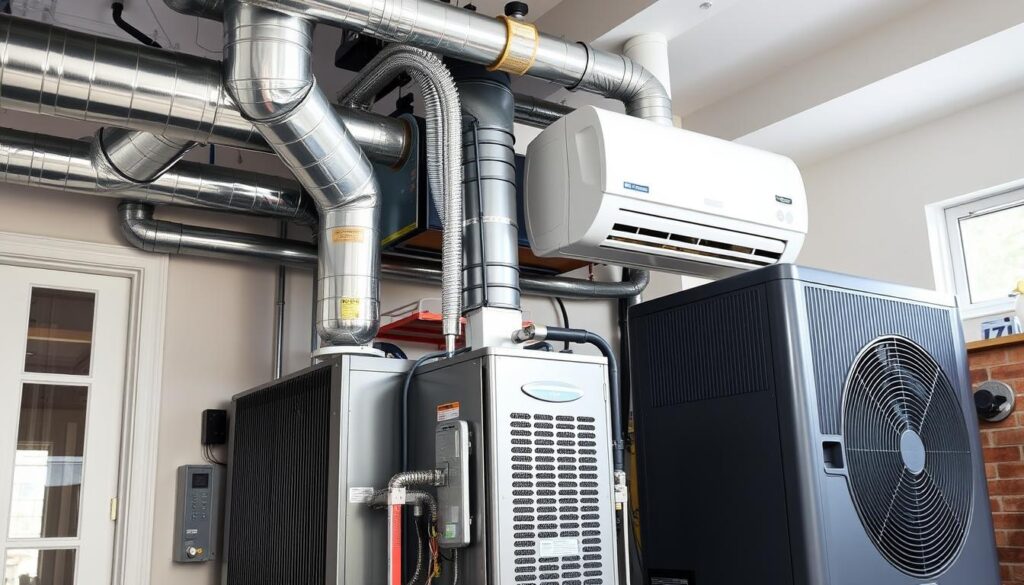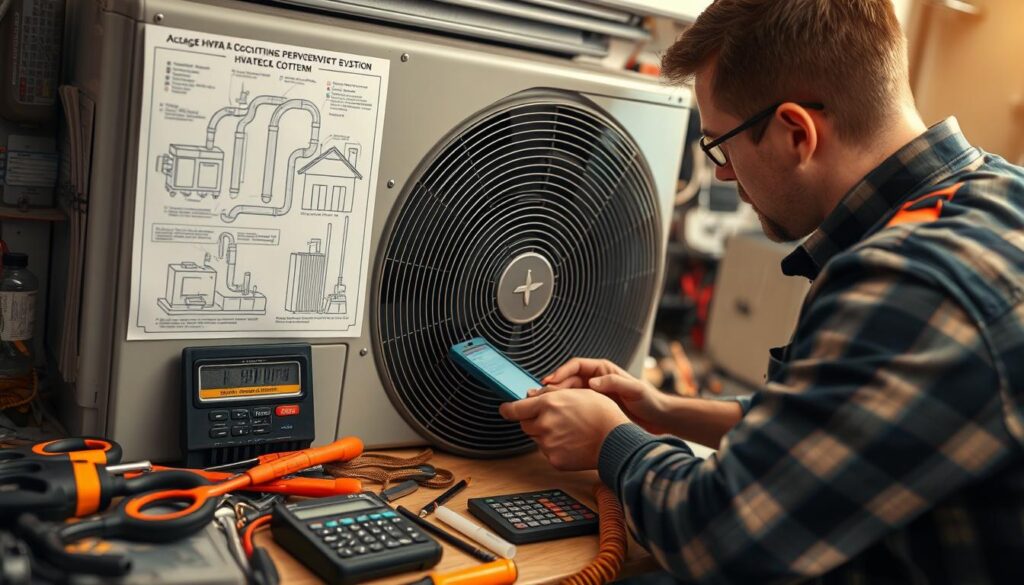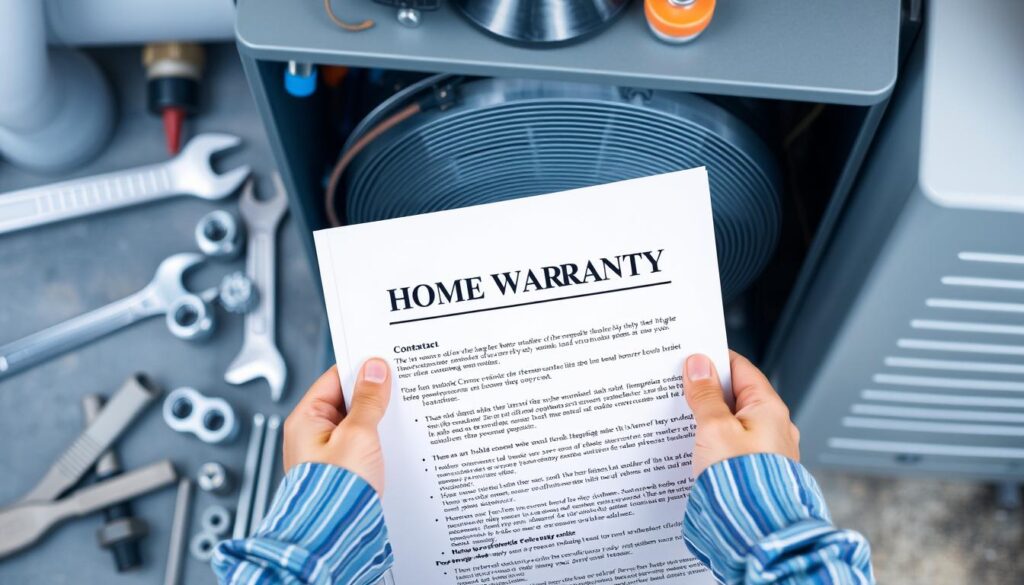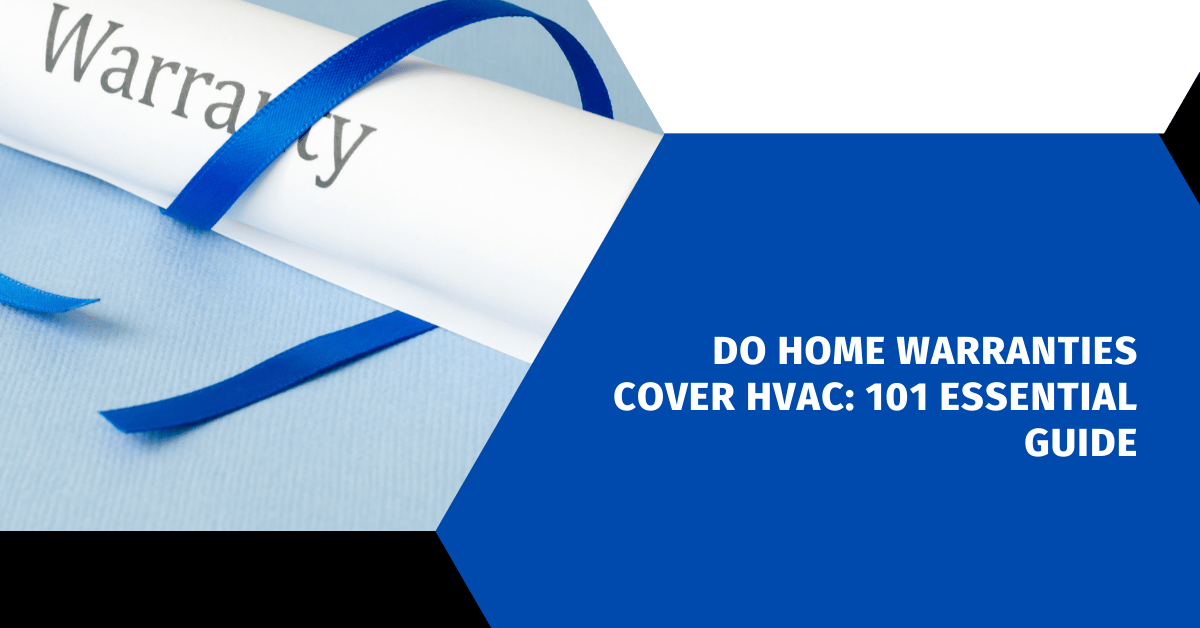Affiliate Disclosure
HVAC Guide Guys is a participant in the Amazon Services LLC Associates Program, an affiliate advertising program designed to provide a means for sites to earn advertising fees by advertising and linking to Amazon.
Do Home Warranties Cover HVAC? Thinking about a home warranty but worried about your HVAC system? Replacing an HVAC system can cost between $5,000 and $34,000. It’s important to know what’s covered. In this guide, we’ll dive into the key points about home warranties and HVAC coverage.

Key Takeaways
- Home warranties usually cover major systems and appliances, like HVAC units.
- They pay for repairs or replacements due to normal wear and tear.
- Most policies start covering after a 30-day waiting period.
- Home warranties are different from homeowners insurance and not needed by lenders.
- Coverage lasts 1-2 years, with longer options available.
Table of Contents
Understanding Home Warranty Coverage for HVAC Systems
Home warranties often include HVAC systems. These systems keep your home comfortable all year. Knowing what your warranty covers can help you get the most out of it.
Types of HVAC Components Covered
Most home warranties cover important parts of an HVAC system. These include:
- Furnaces
- Heat pumps
- Compressors
- Evaporator coils
- Blower motors
- Ductwork
This coverage ensures your heating and cooling systems work well. You won’t have to pay for all repairs yourself.
Standard Coverage Terms
Home warranties usually cost a yearly or monthly fee. There’s also a service call fee for each repair, which is $75 to $125. These fees help pay for diagnosing and fixing HVAC problems.
Coverage Limitations
Home warranties offer great protection but have some limits. They might not cover pre-existing issues, wrong installations, or lack of maintenance. Also, there could be limits on how much is covered per term or item.
It’s important to know the details of your home warranty. This way, you can make smart choices and avoid unexpected costs for your HVAC systems.
Explore Our HVAC Shop
Looking for top-rated HVAC tools, parts, and accessories? Visit our shop and find the perfect solution for your needs.
Visit the ShopDo Home Warranties Cover HVAC: Comprehensive Coverage Analysis
Home warranties often focus on HVAC systems. Most plans include HVAC coverage, but details vary. It’s key for homeowners to understand the HVAC warranty analysis and comprehensive coverage to make a good choice.
Home warranties usually cover the main parts of an HVAC system. This includes the air conditioner, heater, and ductwork. But, there are limits and exclusions to watch out for. It’s vital to check each warranty plan’s terms to know what’s covered.
Some warranties have limits on how much they’ll pay for HVAC repairs or replacements. Also, issues like pre-existing conditions, bad installation, or neglect might not be covered. Homeowners should look closely at the policy to make sure it meets their needs.
Knowing how home warranties cover HVAC systems helps homeowners make smart choices. By carefully reviewing the terms and what’s not covered, homeowners can get the most from their warranty. This way, they can avoid surprise costs for HVAC repairs or replacements.
HVAC Manufacturer Warranties vs. Home Warranty Protection
Both manufacturer warranties and home warranty coverage are key for your home’s HVAC system. Knowing the differences helps you choose the best option for you.
Parts Coverage Differences
Manufacturer warranties cover the parts of your HVAC equipment for 3 to 10+ years. But, they don’t cover labor costs. Home warranties, however, cover both parts and labor for repairs or replacements.
Labor Coverage Comparison
Home warranties are great because they cover labor costs for HVAC repairs. This can save you money when your system breaks down. Manufacturer warranties don’t cover labor, so you pay for it yourself.
Duration of Coverage
Manufacturer warranties last as long as your HVAC equipment does. Home warranties, though, last 1 to 2 years and can be renewed. This means ongoing protection for your home’s systems.
Knowing the differences between manufacturer warranties and home warranties helps protect your HVAC system. It ensures parts and labor are covered for the long term. This knowledge helps you keep your home comfortable and efficient.
| Feature | Manufacturer Warranty | Home Warranty |
|---|---|---|
| Parts Coverage | 3-10+ years | Included |
| Labor Coverage | Not Included | Included |
| Coverage Duration | Tied to Equipment Purchase Date | 1-2 Years, Renewable |
“Homeowners in America rely on the service and coverage of an American Home Shield Home Warranty® to protect their HVAC systems and other major household appliances.”
Common HVAC System Components Protected Under Warranty
Home warranties cover the main parts of your HVAC system. This includes compressors, heat exchangers, motors, and thermostats. They might also cover ductwork, electrical parts, and refrigerant recharging.
But, filters and capacitors are usually not covered. They are seen as maintenance items. Make sure you know what’s included in your warranty plan.
| HVAC Component | Typical Warranty Coverage |
|---|---|
| Compressor | 5-10 years |
| Heat Exchanger | 10-15 years |
| Motors | 5-10 years |
| Thermostat | 1-2 years |
| Ductwork | 1-2 years |
| Electrical Components | 1-2 years |
| Refrigerant Recharging | Covered, subject to limits |
Knowing what’s covered under your home warranty can give you peace of mind. It protects your HVAC system from sudden failures. This ensures your home stays comfortable and safe.
Explore Our HVAC Shop
Looking for top-rated HVAC tools, parts, and accessories? Visit our shop and find the perfect solution for your needs.
Visit the ShopKey Exclusions and Coverage Limitations for HVAC Systems
Understanding the exclusions and limitations of home warranties for HVAC systems is crucial. Home warranties often cover a lot, but there are times when they don’t. Knowing these key points helps keep your HVAC system covered and avoids unexpected costs.
Pre-existing Conditions
Home warranties usually don’t cover pre-existing issues. If your HVAC system had problems before you got the warranty, repairs might not be covered.
Maintenance Requirements
Most warranties require regular maintenance for your HVAC system. This means getting an annual check-up from a certified technician. It keeps your system running well and catches problems early.
Installation Standards
Warranty coverage also depends on how your HVAC system was installed. It must meet the manufacturer’s standards and local codes. If it wasn’t installed right, the warranty might not apply, and you could face extra costs.
Knowing these exclusions and limitations helps homeowners protect their HVAC systems. It ensures they get the most out of their home warranties.
| Exclusion/Limitation | Description |
|---|---|
| Pre-existing Conditions | Issues or problems with the HVAC system that existed before the warranty period began are typically not covered. |
| Maintenance Requirements | Regular professional maintenance, usually at least once per year, is required to keep the warranty valid. |
| Installation Standards | HVAC systems must be installed by licensed technicians and in compliance with manufacturer specifications and local codes. |
“Proper maintenance and installation are key to ensuring your HVAC system remains covered by your home warranty.” – Jane Doe, Home Warranty Expert
Cost Benefits of HVAC Coverage in Home Warranties
Getting a home warranty can save you a lot of money on HVAC repairs and replacements. Without it, fixing big HVAC problems can cost hundreds or thousands of dollars. But, with a warranty, you only pay a small service fee, usually $70 to $150. This can save you a lot on expensive parts like compressors or heat exchangers.
When looking at the cost benefits of HVAC coverage, consider the warranty’s annual cost versus the savings. For example, First American Home Warranty’s Starter plan costs $42 a month. American Home Shield’s plans start at $19.99 a month. Service fees for these providers are between $100 to $125 per claim. Liberty Home Guard’s Appliance Guard plan starts at $49.99 a month, with service fees from $70 to $125 per claim.
Without a home warranty, HVAC repairs can quickly become expensive. Costs for repairs or replacements vary a lot. From $75-$200 for a clogged drain line to $3,800-$7,500 for a new air conditioning system. A home warranty helps manage these costs and avoids the financial stress of big HVAC problems.
“The cost of replacing an HVAC system out of pocket can range between $4,000 and $8,000, making home warranties a cost-effective option.”
In summary, the cost benefits of HVAC coverage in home warranties are significant. They offer homeowners peace of mind and financial protection against unexpected HVAC-related expenses.

Maintenance Requirements to Keep HVAC Coverage Valid
Keeping your HVAC system in good shape is key to keeping your home warranty active. Most warranties need regular checks and services, usually once a year. It’s important to keep records of all maintenance done, like the dates and who did the work.
Regular Service Schedules
Home warranties often have specific maintenance needs, like changing air filters on time. Not doing these tasks can lead to denied claims or even voiding your warranty. Staying on schedule with your HVAC’s maintenance is crucial to avoid problems.
Documentation Requirements
- Save all receipts and service records for your HVAC system’s maintenance.
- Write down the date, service done, and who did the work.
- Have this info ready if you need to file a claim under your warranty.
Ignoring your HVAC system’s maintenance can risk your warranty coverage. By being consistent with maintenance and warranty requirements, you keep your warranty working for you. This ensures your climate control system is protected.
Explore Our HVAC Shop
Looking for top-rated HVAC tools, parts, and accessories? Visit our shop and find the perfect solution for your needs.
Visit the ShopFiling an HVAC Claim Under Your Home Warranty
If your HVAC system breaks down unexpectedly, filing a claim is easy. First, check if your warranty covers the issue. Look at your policy or call your provider.
After confirming coverage, contact your provider to start the claim. You can call, use an online portal, or a mobile app. Be ready to describe the problem in detail.
- Describe the issue: Clearly explain the symptoms and any troubleshooting steps you’ve already taken.
- Schedule a service appointment: Your warranty provider will arrange for an approved technician to visit your home and assess the problem.
- Pay the service fee: You’ll typically be responsible for a small service fee, usually between $75 and $125, when the technician arrives.
- Keep records: Document all communications with your warranty provider and retain copies of any repair invoices or work orders.
If your claim is denied, don’t worry. You might appeal the decision or use arbitration. Knowing your warranty well helps you get the most from it.
| HVAC System Component | Typical Coverage |
|---|---|
| Furnace | Parts and labor for repair or replacement |
| Air Conditioner | Parts and labor for repair or replacement |
| Heat Pump | Parts and labor for repair or replacement |
| Ductwork | Repair or replacement of leaks or breaks |
| Thermostat | Parts and labor for repair or replacement |
Knowing how to file HVAC warranty claims and what your policy covers helps. This way, you can enjoy a well-working heating and cooling system for years.

Choosing the Right Home Warranty for HVAC Coverage
When picking a home warranty for your HVAC, it’s key to compare what’s covered, what’s not, and service costs. Look for plans that cover both repairs and replacements for your HVAC system. This includes heating, ventilation, and air conditioning.
Think about your HVAC’s age and condition when picking coverage. Older systems might need more protection. Newer ones might need less. Also, check the provider’s reputation through reviews and ratings. This ensures you get help quickly when your HVAC needs it.
Coverage Comparison Tips
- Prioritize plans that cover both repair and replacement costs for your HVAC system.
- Assess coverage limits and exclusions to ensure your system’s components are protected.
- Compare service fees across providers, as these can vary widely and impact the overall cost of coverage.
- Look for flexible payment options and the ability to customize your home warranty plan.
Provider Selection Criteria
- Ensure the provider has a network of qualified HVAC technicians in your local area.
- Review the company’s reputation and customer satisfaction ratings to gauge the quality of their service.
- Consider the provider’s coverage for pre-existing conditions, maintenance requirements, and installation standards.
- Evaluate the overall cost-effectiveness of the home warranty plan, balancing coverage, fees, and potential long-term savings.
By carefully looking at home warranty options and choosing the right provider, you can safeguard your investment. This ensures your home’s climate control system is well-protected.
Explore Our HVAC Shop
Looking for top-rated HVAC tools, parts, and accessories? Visit our shop and find the perfect solution for your needs.
Visit the ShopMaximizing Your HVAC Warranty Benefits
A comprehensive warranty for your home’s HVAC system is a lifesaver. To get the most from your warranty optimization and HVAC protection, follow these tips:
- Maintain your system regularly. Clean filters, check refrigerant levels, and inspect electrical connections. This keeps your HVAC unit efficient and preserves your warranty.
- Keep detailed service records. Documenting maintenance and repairs helps validate warranty claims later.
- Understand your coverage terms and limitations. Review your warranty to know what’s included, like parts, labor, and protection duration.
- Report issues promptly. Filing a claim quickly prevents further damage and potential coverage denial.
- Consider combining manufacturer and home warranty coverage. This “double coverage” offers comprehensive protection for your HVAC system.
- Take advantage of any included or discounted maintenance services. Many warranty providers offer these as value-added benefits.
- Stay informed about your warranty renewal dates and any changes in coverage terms. This ensures continuous protection for your HVAC system.
By following these strategies, you can maximize the benefits of your HVAC warranty. Enjoy long-lasting, worry-free comfort in your home.
“A proper HVAC warranty can lead to significant cost savings on repairs, reducing financial burden.”
Conclusion
Home warranties can save you a lot of money on repairs and replacements for your HVAC system. It’s important to know what your warranty covers and what it doesn’t. Keeping up with maintenance and keeping records is key to getting the most out of your warranty.
When picking a home warranty, look at different options and think about what your HVAC needs are. Cates has been helping customers for over 40 years. Their team, including Jacob Alvarado and Jeff, is known for being professional and efficient.
Knowing the value of a HVAC warranty and using it for home protection can give you peace of mind. Cates offers 24-hour service and has highly rated technicians. This means your HVAC system will be well taken care of and any problems will be fixed quickly.

